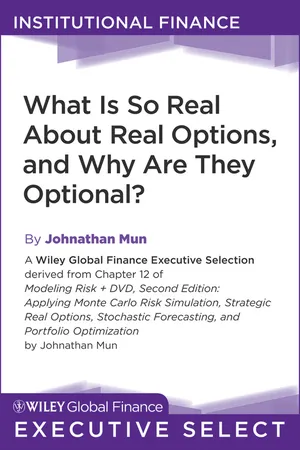![]()
Part Seven
Risk Mitigation
![]()
CHAPTER 12
What Is So Real About Real Options, and Why Are They Optional?
This chapter provides the reader a cursory look at and quick introduction to real options analysis. It explains why only running simulations, forecasting, and optimization are not sufficient in a comprehensive risk management paradigm; that is, time-series forecasting and Monte Carlo simulation are used for identifying, predicting, and quantifying risks. The question that should be asked is, so what and what next? Quantifying and understanding risk is one thing, but turning this information into actionable intelligence is another. Real options analysis, when applied appropriately, allows you to value risk, creating strategies to mitigate risk, and how to position yourself to take advantage of risk. It is highly recommended that you refer to Real Options Analysis: Tools and Techniques, Second Edition (Wiley Finance, 2005) also by the author, in order to learn more about the theoretical as well as pragmatic step-by-step computational details of real options analysis.
WHAT ARE REAL OPTIONS?
In the past, corporate investment decisions were cut and dried. Buy a new machine that is more efficient, make more products costing a certain amount, and if the benefits outweigh the costs, execute the investment. Hire a larger pool of sales associates, expand the current geographical area, and if the marginal increase in forecast sales revenues exceeds the additional salary and implementation costs, start hiring. Need a new manufacturing plant? Show that the construction costs can be recouped quickly and easily by the increase in revenues the plant will generate through new and improved products, and the initiative is approved.
However, real-life business conditions are a lot more complicated. Your firm decides to go with an e-commerce strategy, but multiple strategic paths exist. Which path do you choose? What are the options you have? If you choose the wrong path, how do you get back on the right track? How do you value and prioritize the paths that exist? You are a venture capitalist firm with multiple business plans to consider. How do you value a start-up firm with no proven track record? How do you structure a mutually beneficial investment deal? What is the optimal timing to a second or third round of financing?
Business conditions are fraught with uncertainty and risks. These uncertainties hold with them valuable information. When uncertainty becomes resolved through the passage of time, managers can make the appropriate midcourse corrections through a change in business decisions and strategies. Real options incorporate this learning model, akin to having a strategic road map, whereas traditional analyses that neglect this managerial flexibility will grossly undervalue certain projects and strategies.
Real options are useful not only in valuing a firm through its strategic business options, but also as a strategic business tool in capital investment decisions. For instance, should a firm invest millions in a new e-commerce initiative? How does a firm choose among several seemingly cashless, costly, and unprofitable information-technology infrastructure projects? Should a firm indulge its billions in a risky research and development initiative? The consequences of a wrong decision can be disastrous or even terminal for certain firms. In a traditional discounted cash-flow model, these questions cannot be answered with any certainty. In fact, some of the answers generated through the use of the traditional discounted cash-flow model are flawed because the model assumes a static, one-time decision-making process whereas the real options approach takes into consideration the strategic managerial options cer...
